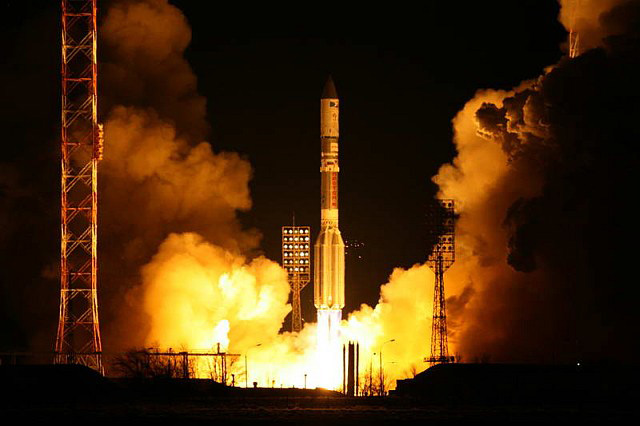Proton Rocket Sends DirecTV Satellite to Orbit

A new high-definitiontelevision broadcasting satellite was deployed by a Proton rocket earlyTuesday, bolstering DirecTV's programming lineup for customers in the United States.
The DirecTV 12 satellitewas bolted atop the 191-foot-tall booster for liftoff at 0022 GMT Tuesday (7:22p.m. EST Monday) from pad 39 at the Baikonur Cosmodrome in Kazakhstan.
The Proton's three corestages heaved thesatellite and Breeze M propulsion module on a ballistic trajectory lessthan 10 minutes after launch. The Breeze M's main engine ignited two minuteslater to put the spacecraft in a stable parking orbit, according toInternational Launch Services, the U.S.-based launch provider.
Four more Breeze M burnsovernight propelled DirecTV 12 to higher altitudes and reduced the spacecraft'sorbital inclination.
Spacecraft separationoccurred on time at 0932 GMT (4:32 a.m. EST) Tuesday, and ILS declared thecompany's seventh mission of 2009 a success.
DirecTV 12 was expected tobe deployed in an orbit with a high point of 22,236 miles, a low point of 3,181miles and an inclination of 20.7 degrees.
The communications payloadweighed about 13,000 pounds at launch, filling nearly all of the Protonrocket's lift capacity. ILS and Russian rocket-builder Khrunichev haveimplemented several recent upgrades to the Proton to give the booster the powerto launch such large satellites, according to McKenna.
Get the Space.com Newsletter
Breaking space news, the latest updates on rocket launches, skywatching events and more!
"DirecTV placed theirtrust and confidence in ILS two years ago with a very significant launch withthe DirecTV 10 satellite. At that time, it was the largest satellite launchedby Proton, demonstrating the increased capabilities of the vehicle," saidFrank McKenna, ILS president. "Now, with DirecTV 12, DIRECTV once againentrusted their business to us with the continuation of this successfulpartnership. We are very proud to play a significant role in the expansion ofdigital television services in the United States with DirecTV."
The satellite will fire itson-board thruster several times in the next few days to reach a circular orbit22,300 miles high and hugging the equator. DirecTV 12 will also unfurl itsmassive solar array wings spanning 158 feet tip-to-tip.
From its station in geosynchronousorbit at 102.8 degrees west longitude, DirecTV 12 will reach subscribers in thecontinental United States, Alaska and Hawaii. The satellite is designed tooperate for 15 years.
The satellite will completeDirecTV's phased expansion of high-definition television service to U.S. households. DirecTV 12 was built by the satellite-manufacturing division of Boeing Co.in El Segundo, Calif.
"DirecTV12 is the third in a line of satellites designed for delivery ofhigh-definition television service to DirecTV's customers throughout thecontinental United States, Alaska and Hawaii," said Steve Schmidt,Boeing's DirecTV 12 program director.
DirecTV 12 will allow thedirect-to-home broadcasting firm to expand its HD capacity by 50 percent,according to Boeing.
The satellite will join twoidentical spacecraft launched in 2007 and 2008. The trio of satellites wereordered to bolster DirecTV's HDTV offering and continue the company's legacy ofuninterrupted service.
"DirecTV 12 isimportant to us because it's the last of our three original Ka-bandsatellites," said Jim Butterworth, vice president of communicationssystems at DirecTV. "It augments our local channel capability, so we cango to more markets with HD programming. And it also is going to give us thecapability to have more movie choices and other services for ourcustomers."
After DirecTV 12 entersservice next year, the company will provide 200 national HD channels and 1,500local HD channels to customers.
"DirecTV 12 is the21st in the Boeing 702 line and will provide significant expansion to thealready unprecedented HDTV service that DirecTV provides to itscustomers," Schmidt said.
The spacecraft carries 131Ka-band transponders for nationwide service and local programming. Thecommunications payload uses two 9.2-foot reflectors and nine smaller antennas.
ILS announced a newinitiative this fall to launch two payloads on a single Proton rocket, makingthe booster competitive for medium-class satellite missions beginning in 2012.
"We will launch twointermediate satellites on the Proton system to (geosynchronous) transferorbit, and that will create a significant offering in that segment of themarket, in which we have not participated previously, at very affordable pricesand reliability," McKenna said.
The launch provider ispartnering with Khrunichev and Orbital Sciences Corp., a leading builder ofsmall communications satellites. The Proton Duo service aims to shave 20percent from the cost of delivering each kilogram of payload to orbit, accordingto ILS.
Monday night's launch wasthe 10th mission overall for the Proton rocket this year.
- Video - Ares I-X Rocket Soars in Test Launch
- How to Spot Satellites
- Image Gallery - Shuttle Discovery's Midnight Launch
Copyright 2009 SpaceflightNow.com, all rights reserved.

Join our Space Forums to keep talking space on the latest missions, night sky and more! And if you have a news tip, correction or comment, let us know at: community@space.com.
Stephen Clark is the Editor of Spaceflight Now, a web-based publication dedicated to covering rocket launches, human spaceflight and exploration. He joined the Spaceflight Now team in 2009 and previously wrote as a senior reporter with the Daily Texan. You can follow Stephen's latest project at SpaceflightNow.com and on Twitter.









